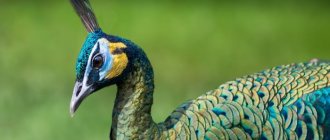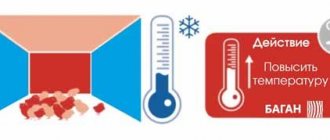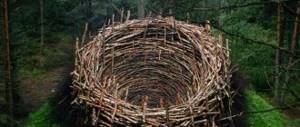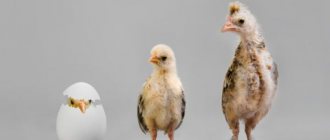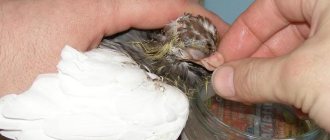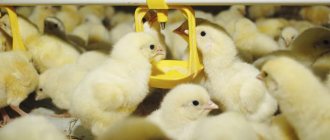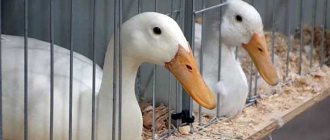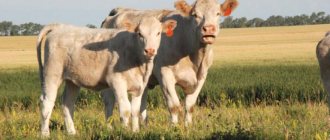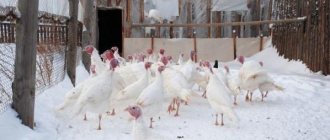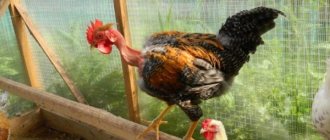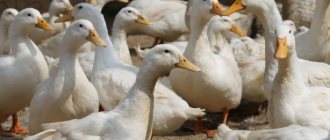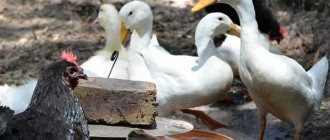Appearance
The whooper has a characteristic “swan” appearance.
It has an oblong body, a long neck, a long yellow beak with a black tip, but without a characteristic growth at the base, and completely white plumage. Legs black. Whooper swan photo
The length of the bird is 140 - 165 cm, weight 7 - 10 kg, wingspan - 2.5 meters. In young individuals, the plumage is somewhat different - grayish with a darker head; Their body acquires a white color only in the third year of life. When swimming, the whooper swan keeps its neck straight, without bending it in the shape of the letter S.
The whooper swan is considered one of the largest among its brothers.
Two whooper swans on the waterBeautiful whooper swanTwo whooper swans in the meadow
Its body is of impressive size, and this breed can be distinguished from another variety by the following characteristics:
- large body measuring from 140 to 170 cm and weighing from 8 to 14 kg (some birds reach a weight of 15.5 kg);
- long straight neck;
- white plumage with a lot of fluff;
- yellow-black beak 9 to 12 cm long;
- short strong legs.
It is noteworthy that whooper swans become snow-white only at the age of 3 years, and until this moment their plumage has a light gray tint. At the same time, the color of the feathers on the head of an individual is always somewhat darker than on the body.
At first glance, it may seem that these birds are leisurely and clumsy. They swim slowly and proudly, but in case of danger they are able to move very quickly. When taking off, the swan first moves its paws across the water for a long time, picking up speed, and only then soars into the air. Since the individuals are very large, they walk little and reluctantly.
Description of the species
The whooper swan is a member of the duck family and the order Anseriformes. In total, the detachment includes seven species of swan:
- Whooper,
- Mute,
- Trumpeter,
- Small,
- American,
- Black,
- Black-necked.
The whooper swan differs from its closest relative, the mute swan, in its more modest, but still impressive for a bird, size. The body length of an adult can reach 180 cm, and the wingspan can reach 280 cm. The body weight of an adult female is from 7 to 10 kg. The male weighs more - from 12 to 16 kg.
Birds have a long neck, but without a characteristic bend, a dense and strong body, and relatively short legs.
Adult birds have snow-white feathers, while young ones are most often gray, white-gray, gray-brown. Adult molt occurs only at the age of three.
Bird placement
Whooper swans live and nest in warm weather in the northern part of forests: Eurasia, from the Scandinavian borders to Scotland, Chukotka, Sakhalin. In the southern part it can be seen on Lake Ladoga, Mongolia, Japan in the northern part of the Caspian Sea. For the winter, they fly to the northern part of the Mediterranean Sea, the Caspian Sea and Central, South and Southeast Asia.
In the spring, in the second half of March, cygnus-cygnus fly to their nests in pairs. The largest nesting populations of these birds have been recorded in the Bairovsky Republican State Complex Nature Reserve, where they breed and protect swans.
Swans arrive at the nesting site in already formed pairs
Keeping poultry on site
The original purpose of a swan in a country house is decorative. Keeping these birds is now fashionable and beautiful. Only sometimes they are bred for commercial purposes:
- down in the production of bed linen;
- feathers and skins are used in the textile industry;
- fattening for slaughter.
However, breeding swans for economic purposes is not as effective as raising ducks or geese. It’s better to just admire the beautiful, proud birds.
Since the whooper is a waterfowl, the presence of a reservoir is considered a prerequisite for its breeding. It’s good if you have a pond, lake or river nearby with areas of small reed pools and calm water.
The lack of a reservoir can be compensated by creating an artificial pond on the site.
Creation of an artificial reservoir
Step 1. Choose a sunny place on the site, free from trees and shade for at least 5 hours a day.
An example of a site for creating an artificial reservoir
Step 2. Decide on the shape and size of the reservoir. Select the parameters to suit your taste, but remember that there should be enough space for large birds to swim freely.
The larger the proposed pond, the better for the swans
Step 3. Initially, dig the edge of the pond using the shapes you have chosen.
It is necessary to dig a ditch - the border of an artificial reservoir
Step 4. Start digging a pit to the desired depth.
Pit for the future pond
Step 5 . Cover the bottom with a special waterproof film.
Ready base for the pond
Step 6. Decorate the bottom and edges of the pond to your taste.
An example of an artificial pond design
Step 7. Remove and mask off excess film.
Finished pond
Step 8. On the water or on the shore it is necessary to install bridges, small rafts or houses - sometimes birds come out of the water and hide in them from the heat, for example.
An example of organizing a walking space for swans
The pond is one of the main places for swans to hang out during the day, providing an opportunity to walk and swim. Around the pond you can install an aviary made of large mesh for walking and flying at short distances. Place haystacks and ventilated reed wigwams around the perimeter, imitating a coastal zone.
Prices for ready-made ponds and bowls for ponds and fountains
Ready-made ponds and bowls for ponds and fountains
Wing trimming
Whoopers are, of course, freedom-loving semi-wild animals, so sometimes they need to be released to fly in the wild. There is a possibility that some individuals will leave your site to nest elsewhere. But in most cases, birds originally raised in captivity and accustomed to human care are returned. If you are worried about this, trim the animal's first wing phalanx a couple of days after birth. The procedure is carried out with disinfected hot scissors, and the cut site is treated with iodine.
Scheme of the operation to trim a bird's wing
There is nothing complicated about keeping whoopers in the summer - the birds almost independently choose the time for walking, swim and sleep on your pond, occasionally walking around it and relaxing in the houses.
Maintenance in winter
Despite the fact that in the wild birds fly south, some of them remain for the winter. This indicates their frost resistance - Whoopers are able to withstand temperatures up to 30 degrees below zero. Some specimens remain on the water, even after it freezes.
However, for severe winters and to avoid frostbite, you need to build a poultry house with the following approximate parameters:
- It is not necessary to maintain a warm temperature, but it should be higher than outside and constant;
- the room should be well ventilated to avoid gas contamination and air humidity. At the same time, drafts leading to colds should not be allowed;
- presence of windows – at a height of 50-100 centimeters;
- make the floor out of wood and cover it with hay (layer of bedding - up to 10 centimeters), which must be changed periodically as it gets dirty.
The room should be spacious so that the whoopers can feel free. There is at least 1 square meter per individual. You can also divide the area into sections, each of which will house one adult animal or young animals. Birds can be driven into the same room at night and in the summer.
Swan enclosure
Reproduction and lifespan
The average lifespan of a whooper swan is 10 years. These birds reach sexual maturity at the age of 3 years, at which time their plumage changes color from gray to snow-white.
Mating games for this species of birds begin at the end of winter. The male makes himself known with a loud, trumpet cry, and also tries to attract the attention of the female with a mating dance. The male's voice resembles the sounds of "kli-kli-kli", and the irritated bird makes a hiss similar to a goose.
Whooper swans have been organizing mating games since the end of winter.
Having split into pairs, the swans begin building nests. More precisely, it is mainly the female who is involved in the arrangement, choosing dry grass, thin branches, reeds as materials, and lining the bottom with her own down and small leaves. The swan's nest is hard to miss; this structure has a diameter of 1 to 3 m and a depth of 50-80 cm.
These birds are considered monogamous, but the popular belief about swan fidelity is greatly exaggerated. After the death of one of the pair, the female or male is able to create a new family.
Having chosen a place to build a nest, a pair of whooper swans considers it their property and does not allow other birds, including members of the flock, to approach this territory.
In one clutch, the female brings from 4 to 7 eggs and hatches them on her own. The male guards the nest and, in case of danger, makes a pipe wrench sound. The female hides the eggs under down and vegetation, and the pair leaves the hatching site. When the danger has passed, they return to the laying site, and the female flies up first, turns the eggs over, and only after that sits on them. Hatching lasts 35-40 days.
The female whooper swan incubates eggs for 35-40 days.
Whooper chicks
Whooper swan chicks are born with light gray fluff on their bodies. They grow quickly and already in the first weeks of life they are able to obtain their own food.
At the age of 3 months, the chicks finally leave the nest, but try to stay close to their parents. As a rule, the family remains together until the following spring.
Whooper swans are excellent parents; they work together to raise and feed their chicks. In case of danger, a female or a male is able to protect their cubs not only from a predator, but also from humans. These birds are large and strong, and a blow from the wing can cause serious injury to the offender.
The spring arrival of birds to nesting grounds lasts from March to May. When the chicks hatch depends on the habitat. So in the southern regions they hatch already in mid-May, and in the northern regions only by the beginning of July.
It is not for nothing that they talk about swan fidelity - these birds are monogamous and create one pair for life. They even fly away together for the winter and stay together all the time. Only in the event of the death of one of the partners can the second find a replacement.
In the photo there are whooper swans
https://www.youtube.com/watch?v=
Returning to the nesting grounds in the spring, pairs choose, if possible, large bodies of water, the banks of which are densely overgrown with grass. Since these birds do not like the company of people, they try to build nests in the depths of forests, on lakes hidden from prying eyes. They can settle on sea coasts if the shores are covered with reeds and other vegetation.
Each couple has its own territory, where strangers are not allowed. If boundaries are violated, swans will defend their possessions in fierce fights. The nest site is usually chosen in dense thickets of reeds, reeds, and cattails. Sometimes right in a pond, at a shallow depth, so that the base of the nest rests on the ground.
The construction of the nest is mostly occupied by the female, who builds it from withered grass. These are quite large structures, with a diameter of 1 to 3 meters. The height of the nest is 0.5-0.8 meters. The inner tray is usually up to half a meter in diameter. The female carefully lays it out with soft grass, dry moss and her down and feathers.
In the photo there is a whooper swan in the nest
The female lays 3 to 7 yellowish eggs, which she incubates. If the first clutch dies for some reason, the couple lays a second one, but with fewer eggs.
The female sitting on the eggs is guarded by the male, who is always nearby. After 36 days, the chicks hatch and both parents take care of them. The babies are covered with gray fluff and look defenseless, like all chicks.
If an alarming situation arises, the parents take them into dense thickets and fly away themselves, only to return when the danger has passed. The brood is almost immediately able to obtain food on its own, and after three months it flies. But, despite this, children stay with their parents all winter, flying away together for the winter, memorizing routes and mastering flight techniques.
Read more: Northern sweet grapes description of the variety, method of planting and care
Pictured is a whooper swan chick
Swans are quite large birds, so small animals and birds of prey do not hunt them. The danger is posed by wolves, foxes, and raccoons, which can attack adult individuals and also destroy their nests.
There is also a danger from humans, because a swan is meat and fluff. But the whooper swan is listed in the Red Book of Europe and the countries of the former USSR. The lifespan of a whooper swan is about 10 years.
Its numbers in Europe began to increase slightly, but in the west of Siberia the birds cannot recover, since these are industrial regions that are not conducive to the reproduction and life of these beautiful creatures of nature.
The whooper swan is a monogamous bird. Whoopers create families once and for all; a new partner is found only if the previous one dies. The pair nests together, flies away for the winter and returns back. For the first year, young individuals also travel with their parents.
where will we build the nest? Whooper swan photo
The whooper uses a pile of vegetation as a nest, which is raked together by the male and female. In diameter, such a nest can reach 1 - 3 meters, and in height 0.8 - 1 meter. The nest site is the coast of a reservoir, overgrown with abundant vegetation. Sometimes birds nest near human settlements if no one disturbs them.
Birds build a nest from reeds and reeds. The tray is lined with moss and grass, down and feathers. In May-June, the female lays 3-6 eggs, which she incubates herself.
whooper swan in the nest photo
At this time, the male guards the nest and the territory adjacent to it. Males strictly guard their areas; fights even occur between them - most often they spend them on the water.
After five weeks, the chicks appear and quickly become independent. At the moment of danger, the parents hide the chicks in high thickets, and they themselves fly away, but then return.
In the wild, the whooper swan lives for about 10 years.
Description of the bird
The whooper swan (Cygnus cygnus) is a large migratory bird with a vast habitat from the coast of Scandinavia and Scotland to Sakhalin Island and the Chukotka Peninsula.
| Scientific classification | |
| Domain | Eukaryotes |
| Kingdom | Animals |
| Sub-kingdom | Eumetazoans |
| No rank | Bilaterally symmetrical |
| No rank | Deuterostomes |
| Type | Chordata |
| Subtype | Vertebrates |
| Infratype | Ghostostomes |
| Superclass | Quadrupeds |
| Treasure | Amniotes |
| Class | Birds |
| Subclass | fantail birds |
| Infraclass | New palates |
| Treasure | Galloanseres |
| Squad | Anseriformes |
| Suborder | Lamellaridae |
| Superfamily | Anatoidea |
| Family | Duck |
| Subfamily | Goose |
| Tribe | Cygnini |
| Genus | Swans |
| View | Whooper swan |
| International scientific name | Cygnus cygnus |
| Security status | Least Concern |
| The Red Book of Russia | The view disappears |
What does it look like
One of the largest representatives of its kind. It nests in the north of Eurasia, preferring ponds, quiet rivers of the taiga and forest-tundra. Nature has awarded the whooper with a large number of feathers (up to 25,000) and warm down to protect it from the cold.
Main characteristics:
- oblong body (140-155 cm);
- wingspan (265-280 cm);
- tail length (160-205 mm);
- beak length (9.2-11 cm);
- weight - 6.7-12.7 kg.
Females are significantly smaller in size than males. The lifespan of this vila is on average 10-12 years. Distinctive features of the species:
- long, straight neck without an S-shaped bend;
- triangular yellow or yellow-orange beak with a black tip, no bump or swelling;
- nostrils located close to the base of the beak;
- strong black paws;
- there are 10-11 pairs of tail feathers on the tail.
Important! Birds acquire a typical color after 3 years of life; young individuals have smoky-gray plumage, pink beaks and paws.
Character and lifestyle
The whooper swan is clumsy on land, so it rarely and reluctantly leaves the body of water. In the water it moves little, the straight neck is extended, the head is directed horizontally forward. The wings are pressed tightly to the body, and not raised, like a sail. In case of danger, the speed of movement increases, so it is difficult to catch up with the bird even on a boat.
Habitats and migrations
It takes off slowly, often moving its paws through the water and pushing off with its wings. Once in the air, he feels confident. Its unique plumage, body structure, and developed muscles allow it to fly at altitudes of up to 8000 m and reach speeds of up to 80 km/h.
What does it eat?
The whooper swan is practically omnivorous. It feeds on small fish and invertebrates, but prefers plant foods, eating roots, shoots, and tubers of aquatic vegetation. Bird nesting sites are always revealed by a characteristic mark - holes in shallow water. With webbed paws, the whooper tears up the soil in search of food, then plunges its head into the water to get what it has caught.
Thanks to its long neck, the whooper can collect food at a depth of 1-1.2 m. Young individuals need a lot of protein, so they prefer aquatic insects and crustaceans. In winter, they switch to ground food, eat grass and agricultural products (wheat, carrots, potatoes)
Important! Bread of any kind is contraindicated for swans; it causes a fermentation process in the stomach. Without qualified help, the bird may die from poisoning. The best delicacy is wheat and corn.
Reproduction
Whoopers look after a future pair at an early age, but begin nesting only at 5 years of age. Monogamous, they change partners only after the death of the previous one. Wonderful parents, they share responsibility and care for the cubs equally.
The process of giving birth to offspring is divided into several stages:
- Returning from wintering, the beginning of mating dances with head shaking, touching the tips of trembling wings and clicking.
- Finding a nesting site. They prefer freshwater bodies of water with rich vegetation.
Sometimes they build a nest in shallow water to protect their offspring from attacks from land.
- Construction of a nest. The male brings material (dry grass, leaves, moss), the female forms it into a bowl with a diameter of about 1 m, lining the bottom with her down.
- Egg laying from April to June. From 3 to 7 yellowish eggs, weighing approximately 320 grams. The female incubates the eggs, the male provides protection.
- The appearance of chicks. After 30-37 days, the offspring hatch and are ready to obtain food on their own.
- Security and education. Parents provide security and develop survival skills in the chicks.
- Preparing for independent living. After 3 months, the cubs begin to fly, but remain with their parents for the winter to learn the art of long-distance flights and study the route.
The couple does not tolerate intrusions into their territory. It is very important that they are not disturbed during nesting.
Natural enemies
The whooper swan is able to repel attacks from small predators thanks to its strong wings. But foxes, arctic foxes, raccoons, and wolves not only attack adult individuals, more often they cause harm by destroying clutches and killing helpless chicks.
In the water, otters may covet the nest. In the air, danger comes from birds of prey. The owner of the taiga, the brown bear, is not against eating swan eggs.
Wintering
Overcoming long distances, whooper swans fly in small flocks to the north of the Mediterranean, the coast of the Caspian Sea, to Central, South and Southeast Asia to survive the cold winter there and gain strength before returning to their nests.
The strongest member of the flock flies first so that the flock can save strength in the aerodynamic currents emanating from the flapping of its wings. Some individuals remain at nesting sites, provided there is an ice-free reservoir and sufficient food.
Flight of the Whoopers
These swans fly in small flocks. The migration is well observed in the Eastern part of Siberia, in Primorye. They fly day and night at high altitudes. At the initial stage of migration in spring, individual birds can be seen. When the migration is in full swing, screaming swans unite in groups of 10 individuals, lining up at an angle.
Well-developed wings allow whoopers to make long flights
Number of species
There is no exact data on the number of whooper swans, but new habitats are regularly discovered in the European part of the continent. As a rule, birds settle in quiet creeks and near lakes.
[adsp-pro-6]
It should be noted that there is a trend towards a decrease in the number of species in their former habitats. However, in the northern regions, swans are found much more often than in the southern ones. This is due to the fact that in hard-to-reach, swampy regions with a harsh climate, places suitable for nesting of these birds are destroyed less often than in the southern parts of the continent.
Whooper swans are more common in northern regions.
In addition, the population size is affected by the presence of wolves, foxes and raccoons in the area. These animals pose a serious danger to whoopers; they destroy nests by eating eggs and newborn chicks.
Interesting Facts
In addition to frequent mention in folklore, the following interesting facts about whooper swans can be cited:
- The whooper swan is considered one of the largest birds in Russia.
- The main difference between this type of bird is the absence of a bump in the beak area.
- Whoopers are the only species of swans with a straight neck that has no bend.
- An adult of this species is very strong, and with a blow of its wing is capable of killing a small animal or breaking a person’s arm.
- Among the males of this species, violent fights over females or territory are not uncommon.
- For many peoples living in the Trans-Urals, these large birds were considered totem animals, and some tribes believed that man descended from the swan.
- The Siberian peoples believed that swans turn into snow in the winter, and in the spring they return to their former appearance.
- In ancient Greece, the Milky Way was called the “Swan Road”.
These mysterious, beautiful birds have always attracted the attention of people. Legends, fairy tales, songs and poems were written about them, and today the swan is considered a symbol of love and fidelity.
In the video you can see whooper swans in the wild.
- The graceful physique of the swan has served as the personification of beauty, romance and true love for humans. The necks of two swans swimming towards each other are also shaped like a heart.
- The whooper swan is the national bird of Finland. Mute swan - Denmark. The black swan is featured on the emblem of Western Australia.
- Swans are royal birds. In England they are legally the property of the Queen. But during the times of Kievan Rus, absolutely everyone ate fried swans. In addition, birds were hunted for their down and feathers. Thus, the plumage of a mute swan consists of about 25,000 feathers.
- Swans usually live between 15 and 20 years. The oldest mute swan recorded in Denmark was 40 years old.
Origin of the species and description
Photo: Whooper Swan
Whooper swans breed in forest-tundra and taiga zones throughout Eurasia, south of the breeding range of Bewick swans, extending from Iceland and northern Scandinavia in the west to the Pacific coast of Russia in the east. Five main population groups of whooper swans have been described:
- Icelandic population;
- population of Northwestern continental Europe;
- population of the Black Sea, Eastern Mediterranean Sea;
- population of Western and Central Siberia, Caspian Sea;
- East Asian population.
However, there is very little information on the extent of whooper swans' movements between the Black Sea/Eastern Mediterranean and the Western and Central Siberian/Caspian Sea regions, and therefore these birds are sometimes considered to be a single Central Russian breeding population.
The Icelandic population breeds in Iceland and most migrate across the Atlantic Ocean 800–1400 km in winter, mainly to Britain and Ireland. About 1,000–1,500 birds remain in Iceland during the winter, and their numbers depend on weather conditions and food availability.
Video: Whooper Swan
The northwestern continental European population breeds throughout northern Scandinavia and northwestern Russia, with increasing numbers of pairs breeding further south (especially in the Baltic countries: Estonia, Latvia, Lithuania and Poland). Swans migrate south for winter, mainly in continental Europe, but some individuals are known to have reached south-east England.
The Black Sea/Eastern Mediterranean population breeds in Western Siberia and possibly west of the Urals, and there may be some degree of cross-relationship with the Western and Central Siberian/Caspian Sea population. Population of Western and Central Siberia/Caspian population. It is believed to breed in Central Siberia and by winter between the Caspian Sea and Lake Balkhash.
The East Asian population is widespread throughout northern China and the eastern Russian taiga during the summer months and winters primarily in Japan, China and Korea. Migratory routes are not yet fully understood, but calling and tracking programs are underway in eastern Russia, China, Mongolia and Japan.
Screams of whoopers
The whooper received its name from the ringing, trumpet calls it makes. Most often it makes sounds when flying.
The voice of cygnus cygnus is similar to the ringing sound of a trumpet. The sounds of whoopers in the spring are very sweet. At this time, high in the sky, making sounds, the swans joyfully call to each other. The voices of such a roll call shimmer with the noise of spring streams and with all the spring sounds that can revive nature after winter.
In an irritated state, whooper swans make a sound similar to “klikliklikli”, or make a hiss similar to that of a goose.
Sometimes you can hear plaintive clicks, like the sound of a wind trumpet. People call such sounds the last swan song. To this day, scientists cannot understand how swans sense the approach of death.
To communicate with each other, whoopers use a rich palette of sounds
Spreading
Whooper swans nest on the northern borders of Eurasian forests from Scandinavia and Scotland to Chukotka and Sakhalin. In the south they are found as far as Lake Ladoga, Mongolia, northern Japan, and the northern part of the Caspian Sea. They fly to the north of the Mediterranean Sea, to the Caspian Sea, as well as to Central, South and Southeast Asia for the winter.
Only some birds remain to spend the winter at their nesting sites. Whoopers usually do not fly away for the winter from Scandinavia, the White and Baltic Seas. Swans living in non-freezing or not completely freezing water bodies of Eurasia also remain for the winter. Whoopers fly to nesting sites in pairs throughout the spring, starting in mid-March.
In Russia, in the Omsk region, the whooper swan is found in the reservoirs of the Tavrichesky, Bolsherechensky districts, and on Lake Buturla in the Nazyvaevsky district. During the migration period, it regularly appears in the reservoirs of Bird Harbor. The largest nesting concentrations of whooper swan are noted in the Bairovsky Republican State Complex Reserve, one of the main activities of which is the reproduction and protection of swans.
egg of Cygnus cygnus – Toulouse Museum
Swans protection
Whoopers are a specially protected species and are listed in the International Red Book of many countries. The number of the species is constantly declining due to human development of the lands on which the whooper nests, as well as due to pollution of coastal waters.
However, in some regions of our country it was possible not only to completely restore, but also to increase the population of this beautiful bird.
So in 2007, the whooper bird was excluded from the Red Book of Karelia - the work to preserve the species turned out to be more than successful. But hunting for whoopers is strictly prohibited even today. Particularly large populations on the territory of the Karelian Republic are noted on the coast of the White Sea and Lake Onega. In other regions, the situation is more sad. In the Perm region there are only a few places where whoopers nest. And in recent years, only two pairs of birds have returned to the nesting site. About 300 pairs nest annually in the Altai Territory, although previously the number of individuals returning to their nesting sites exceeded several thousand.
Nesting and laying
In the fourth year of life, young swans develop “adult” plumage and reach sexual maturity. Pairs first begin to form in winter. They usually connect forever and become very attached to each other. Only if one of the partners dies can a change occur.
The pair continues to be together even after nesting. They spend the winter together and also migrate north together in the spring. Young swans and their families spend their first winter.
The pair builds a nest together, consisting of a large amount of vegetation: reeds, reeds, sticks, moss, branches, etc. The base is lined with the finest materials and down. The female takes care of this; she also plucks the fluff from herself.
The size of the nest at the base reaches one meter and a height of up to 80 cm.
The swan couple considers the area around the nest to be their property and does not allow their whooper relatives there.
Whoopers build nests from reeds and branches
A clutch can contain from 4 to 7 eggs, which are incubated by the female. The male is the guardian of the female and eggs. If a whooper swan senses danger, it gives a voice. At this time, the female covers the eggs with down and vegetation from the nest and flies away after the male. Upon returning, she flies ahead of the male and turns them over before landing on the eggs. The duration of incubation is from 35 to 40 days.
Read more: Breeding rabbits as a business, profitability business plan
Features of character and lifestyle
Photo: Whooper swan bird
The swan nesting season is timed to use readily available food supplies. Nesting usually occurs from April to July. They nest in areas with sufficient food supplies and shallow and unpolluted water. Usually only one pair nests on one body of water. These nesting territories range in area from 24,000 km² to 607,000 km² and are often located near where the female hatched.
The female chooses the nest and the male defends it. Swan pairs are more likely to return to the same nest if they have been able to successfully raise young there in the past. Pairs will either build a new nest or repair the nest they used in previous years.
Nesting sites are often located in slightly elevated areas surrounded by water, such as:
- on top of old beaver houses, dams or mounds;
- on growing vegetation that either floats or is fixed to the bottom of the water;
- on small islands.
Nest construction begins in mid-April and can take up to two weeks to complete. The male collects aquatic vegetation, grasses and sedges and transfers them to the female. She first piles plant material on top and then uses her body to form a depression and lay her eggs.
The nest is basically a large open bowl. The inside of the nest is covered with down, feathers and soft plant matter found in its surroundings. Nests can reach a diameter of 1 to 3.5 meters and are often surrounded by a ditch of 6 to 9 meters. This ditch is usually filled with water to make it more difficult for predatory mammals to reach the nest.
Lifestyle
She spends most of this life in the water, swimming leisurely. If a whooper swan is frightened, it begins to move away from its pursuer at great speed, so that it is difficult to catch up with it even by boat.
When the whooper takes off, it “runs” through the water for a long time, kicking its legs and gradually gaining height. The whooper walks poorly on land, so it very rarely and reluctantly gets out onto land.
whooper swan in flight photo
The whooper is so named for its characteristic sound that it makes in flight or during the courtship dance. This is a loud trumpet cry. At the moment of irritation, he can make something like “kli-kli-kli”, and also hiss like a goose.
The plaintive cry that swans make shortly before death is also known; this is the very “swan song”. Scientists still have not figured out how swans can predict their own death.
feathers need to be cleaned. whooper swan photo
The whooper swan is a cautious bird; it tries not to swim close to the shores and stays in a wide part of the reservoir. If the pursuer still overtakes the whooper, he can hit him with blows of his wings: one such blow is very strong and can break a child’s arm.
The swan molts twice a year. During this difficult period, birds stay on the water.
The whooper swan got its name from its loud, trumpet-like calls, especially often made in flight. When swimming, it holds its neck vertically, its wings tightly pressed to its body. Usually the whooper swan, like all swans, swims slowly and majestically, but if you chase it, you can hardly catch it even by boat.
Taking off from the water, it runs for a long time, flails its paws through the water, gradually gaining speed and height. He does not like to walk on the ground and does it extremely reluctantly and rarely. The whooper is a cautious bird that stays in wide expanses of water, away from the shores. The blow of the whooper's wing is so strong that it can break a child's arm.
Nutrition
Whooper swans feed mainly on plant foods, aquatic plants, and also eat small invertebrate animals. The chicks feed mainly on animal food in shallow water, obtaining food from the bottom, half-diving into the water, like ducks.
Reproduction
Whooper swans are monogamous birds that form pairs for life, and the birds stay together even during the winter. A change of partner is possible only if one of the swans dies. Whoopers nest on the banks of reservoirs: possibly large lakes covered with dense thickets. As a rule, these are deep forest lakes, far from people.
Sometimes it nests on sea coasts if there are reed thickets there. If the birds are not disturbed, they nest near human habitation. The whooper's nesting area is a fairly vast area where other swans are not allowed; if the boundaries are violated, violent fights occur between whoopers, usually on the water.
The nest is made up of huge piles of withered vegetation, which is collected mainly by the female. The diameter of the nest at the base is about 1 m, sometimes up to 2-3 m. Height is about 0.5-0.8 m. The diameter of the tray is about 40-50 cm. The nest is made in thickets of reeds, reeds or cattails, less often in shallow water, where the nest rests on the bottom of the reservoir.
The bottom of the tray is lined with grass, moss and feathers plucked from the belly and chest of the female. There are 3-7 eggs in the clutch, which are incubated by the female. The eggs are white or yellowish. When a clutch dies, a second one is laid, but always with fewer eggs. While the female incubates the eggs, the male remains nearby and guards the nest.
Voice
The usual voice of a whooper swan is a loud trumpet "gang-go, gang-go, gang-go", usually heard in mating dances.
Natural enemies of the whooper swan
Photo: Whooper swans
Human activity threatens whooper swans.
Such activities include:
- hunting;
- destruction of the nest;
- poaching;
- habitat loss and degradation, including restoration of inland and coastal wetlands, especially in Asia.
Threats to whooper swan habitat include:
- agricultural expansion;
- overgrazing of livestock (eg sheep);
- draining wetlands for irrigation;
- cutting down vegetation to feed livestock for the winter;
- road development and oil pollution resulting from oil exploration;
- operation and transportation;
- anxiety from tourism.
Illegal swan hunting still occurs, and collisions with power lines are the most common cause of death for whooper swans wintering in northwestern Europe. Lead poisoning associated with ingestion of lead shot during fishing remains a problem, with a significant proportion of specimens tested having elevated blood lead levels. The species is known to have contracted avian influenza, which has also harmed the birds.
In summary, current threats to whooper swans vary by location, with causes of habitat degradation and loss including overgrazing, infrastructure development, development of coastal and inland wetlands for farming expansion programs, hydroelectric dam construction, and disturbance from tourism and oil spills.
Whooper chicks
Whooper swans migrate to their nesting sites starting in March and ending in May.
In southern regions, chicks appear earlier, in mid-May; in middle regions, at the end of May; in northern regions, only at the end of June or early July.
Newborn whooper chicks are covered with gray fluff. They are able to quickly adapt to new conditions and show rapid growth, and are able to obtain food for themselves. They can fly on the wing at three months.
In moments of danger, parents diligently protect their chicks. Often, in times of danger, adult swans take away the young chicks and hide them in the thickets, and they themselves fly away, but soon return.
Whooper swan chicks stay with their parents throughout the year
Whooper Habitats
The habitats of the whooper swan are Scandinavia, Scotland, Chukotka and the Sakhalin Peninsula. These birds can also be found on Lake Ladoga, in the northern part of Japan, Mongolia and near the Caspian Sea.
Whooper swans migrate to the Mediterranean Sea in winter.
This species of swans is migratory, and in winter they move to the Mediterranean Sea, the shores of the Caspian Sea and to the southern and southeastern parts of Asia.
However, not all birds leave their nesting places during the cold season; for example, the inhabitants of Scandinavia and the coasts of the White and Baltic Seas do not fly to warmer climes. In addition, whooper swans, which live near the ice-free lakes of Europe and Asia, remain for the winter.
For living, individuals choose areas near open water bodies, with shores abundantly overgrown with vegetation, and whooper swans can also be found on forest lakes and by the sea. Very rarely these birds live close to human habitation.
Literature
- Beycek V., Stastny K. Birds. Illustrated encyclopedia. - M.: Labyrinth-press, 2001.
- Akimushkin I. Animal world. Birds, fish, amphibians and reptiles. - M.: Mysl, 1995.
- The world of animals in 7 vols. T.6 Birds. - M.: Education, 1986.
{amp}gt; Links
- Vertebrates of Russia: Whooper Swan
| Latin name: | Cygnus cygnus |
| Squad: | Anseriformes |
| Family: | Duck |
| Additionally: | European description of the species |
Appearance and behavior. Large, almost as big as a mute mute. Body length 155–170 cm, wingspan 225–250 cm, weight 7–10 kg.
Description. Of the main differences, the most striking are the large trapezoidal yellow spots on the sides of the black beak. They occupy areas from its base to the top and extend forward approximately 2/3 of the length of the beak, in contrast to the small swan, in which these spots do not reach the middle of the beak. When at rest, the bird's neck is kept straight and its head horizontal.
In young birds in juvenile plumage, the spot on the beak is whitish; during winter it acquires a light pinkish-yellow hue. In birds of the second and third years of life, the trapezoidal spots on the beak and frenulum are pale yellow, duller than in adult birds. The paws are always black.
Voice. The voice of the whooper is a loud trumpet “krru, krru-ru” and a quieter guttural coo. The sound of wings in flight is almost inaudible at a great distance. At the culmination of the mating ritual, the birds, beak to beak with straight necks, first talk quietly, and then synchronously cross their straight necks thrown forward and “trumpet” loudly. During aggressive demonstrations towards territory violators, the daylight male bends his neck forward and downward with a bend.
Distribution, status. The whooper's nesting range occupied a strip from the forest-tundra to the forest-steppe and northern steppe of Eurasia, but due to direct persecution and disturbance by humans in recent centuries, it disappeared from most densely populated areas. Now the main nesting areas of the species are in taiga regions and on the largest forest-steppe and steppe lakes in Western Siberia and Northern Kazakhstan.
Lifestyle. In spring it appears already at the end of March, mass migration occurs in April or early May. On migration, family groups or flocks of up to 20 birds are most common. It begins nesting at the end of April or May. Settles on large lakes with heavily swampy shores, among tracts of raised bogs or in the floodplains of large rivers overgrown with impassable willows. Strictly territorial.
A nest made of last year's grass, reeds and reeds, similar to the nest of the mute mute, is located in thickets of coastal semi-submerged or terrestrial herbaceous vegetation or in reeds 10–20 m from open water. Massive nests are built from grass, moss, thin twigs with a small addition of fluff. A clutch usually contains 4–7 (up to 9) white eggs.
Read more: Grape varieties in alphabetical order, grape varieties with photos and descriptions, catalog
The female incubates the clutch, the male stays nearby and guards the nest. In case of danger, the incubating female lies flat on the nest, lowering her neck extended forward. During the initial period of leading broods, when danger appears, small chicks are hidden in reeds, and they themselves swim to the other edge of the reservoir or even fly away from it. The rate of development of chicks is higher than that of mute birds; young birds acquire the ability to fly at the age of 2–2.5 months.
From mid-May on migrations, groups of non-breeding whoopers can visit water bodies outside the nesting areas. The largest concentrations of molting whoopers are located on tundra lakes and in the deltas of northern rivers. The autumn migration is late, the first birds appear in the middle zone from the end of September, the majority - at the end of October and even in November, on the eve of the first snowfalls.
Whooper swan (Cygnus cygnus)
White-eyed Pochard Aythya nyroca White-fronted Goose Anser albifrons Barnacle Goose Branta leucopsis White Goose Anser caerulescens Great Merganser Mergus merganser Eider Somateria mollissima Comb eider Somateria spectabilis Gogol Bucephala clangula Goosefish Anser fabalisLong-nosed merganserMergus serratorCanada gooseBranta canadensisShort-billed bean gooseAnser brachyrhynchusRed-headed duckAythya ferinaRed-breasted gooseBranta ruficollisRed-nosed duckNetta rufinaMallardAnas platyrhynchosMute swanCygnus olorL ducksMergellus albellusSea duckAythya marilaSea duckClangula hyemalisMarbled tealMarmaronetta angustirostrisGarTadorna ferrugineaShelduckTadorna tadornaLeaping gooseAnser erythropusDawduckOxyura leucocephalaWigeonAnas penelopeGrey duck
Whooper swan (Cygnus cygnus) Eng. Mute swan
The molting of flight feathers in immature second-year birds on the northern coast of the Caspian Sea begins on the 20th of June, while adult breeding birds molt somewhat later (Tugarinov, 1941). The change of their flight feathers on Kanin Island takes place in the first ten days of July, and on July 9, the flight feathers of the local ones are in tubes and are still completely undeveloped (Dementyev, 1935); on Novaya Zemlya, a complete molt of swans is observed at the end of July (Gorbunov, 1929), on In Anadyr, molting begins in mid-July (Portenko, 1939), and on the Shantar Islands, completely flightless swans were observed in large numbers on August 20 (Shulpin and Dulkeit, 1937). By the end of August, the full summer molt of adults and subadults usually ends.
The change from down to feather in young people begins when they reach approximately half the size of adults. Approximately two weeks after the end of the full summer molt, the partial autumn molt of the contour plumage and tail feathers begins, which drags on for a long time.
During the molting period, swans move to large open water spaces, where they are completely safe from all possible enemies, with the exception of humans. Or, in rare cases, during this time they climb into the most remote and inaccessible areas of inland water bodies. Nutrition . The food for whooper swan chicks are various aquatic larvae caught in shallow waters and off the coast. Adults, in addition to small aquatic animals, also use aquatic plants. Immersing their necks in the water in shallow places, swans dig for a long time in one place in the silt, digging a rounded hole in it up to 80 cm in diameter and extracting rhizomes and young shoots of aquatic plants from it. At the same time, small aquatic animals swimming near the bottom or located in the silt are also caught. Feed is usually collected in the mornings and evenings. They cannot feed in deep places.
In wintering grounds, where they are not disturbed, swans remain for a long time in the same shallow places, even if the latter, due to rising water, become inconvenient for obtaining food on them. Bad weather and winter storms often prevent swans from feeding normally, but swans rarely fly to other places, even if they have to starve. Exhausted from lack of food, they are then unable to rise into the air for some time, but then quickly regain their strength. However, under prolonged conditions unfavorable for obtaining food, in some cases they die from exhaustion (Isakov, 1940). Fishing. Apart from humans, the whooper swan has no other enemies; under the influence of humans, over the last century the whooper swan population has decreased significantly. First of all, people deprive the whooper of nesting lands, using them for their own needs, and in this way these birds disappeared from a number of places in Europe and the European part of the USSR, and only in Siberia, where there are still many swampy, inaccessible spaces, the whooper is found in some numbers. In huge numbers, sometimes in the hundreds at once, swans were exterminated during molting by “racing,” that is, chasing moulting swans on sailing boats and then using nets in wintering grounds. Currently, due to a significant reduction in the number of whoopers, “races” are almost never organized for them, and net fishing is generally prohibited.
Story
The whooper swan is often mentioned in folklore and is a symbol of fidelity, love and purity. But there are other, no less interesting, facts about whoopers:
- the main difference between individuals of this breed and other species is the absence of a characteristic bump on the surface of the whooper’s beak;
- whoopers are the only breed of swans that have a straight, long neck without a bend;
- males quite often engage in bloody battles for habitat areas, or for a chosen mate;
- adult individuals are quite strong and have incredible strength, and therefore with just one wing they can inflict a fatal blow on a small animal and even break a human arm;
- many peoples of the Trans-Urals exalted these birds and made totems with their appearance, and some peoples believed that they originated from swans;
- In Siberia, there was a belief that with the onset of winter cold, whoopers turn into snow, and by spring they turn into swans again.
At all times, whooper swans have attracted human attention. Many legends and fairy tales, poems, songs and fables have been written about them. And in the modern world, swans represent a symbol of fidelity and eternal love.
In the description of the whooper's external parameters there are no unusual features that would distinguish it from the generally accepted understanding of the appearance of birds of this breed. But there are still characteristic features of the whooper breed.
Firstly, these are the body dimensions:
- the weight of birds can reach from 7.5 to 15 kilograms;
- body length varies from 140 to 175 centimeters;
- the wings fit tightly to the body, the wingspan ranges from 265 to 280 cm;
- the neck is very long and straight;
- the beak reaches 10-12 centimeters in length, colored bright lemon with a black tip;
- In size it exceeds the swans of the “small” breed, but is slightly inferior to the mute swan.
As for the coloring of whoopers, it is immediately worth noting that their snow-white adult plumage appears only at the age of 3 years, just when puberty begins. Until this age, swans have light gray plumage, and the color of the feathers on the head is always somewhat darker than on the back.
Whooper swans
The places where the whooper swan lives are represented by the Scandinavian Peninsula, Scotland and Sakhalin. They can also be seen in the northern part of the Caspian Sea, Mongolia and Japan, and the whooper swan also lives on the shores of reservoirs in the Perm Territory and on large lakes in Chukotka.
This is a migratory breed of swans, so with the onset of winter they fly to warmer climes to the Mediterranean Sea, as well as to the middle southern part of Asia. The flight of whoopers can be very long.
These are very hardy birds, so when gathered in a flock of 10-12 individuals, they can fly for 2-3 days without rest, rising to a flight altitude of 6 to 8 thousand meters from the surface of the earth.
If necessary, birds descend to the surface of the water surface of large reservoirs, where they rest and gain strength to complete their migration.
At the end of winter, the birds return to the former habitats of whoopers, after which mating dances begin. Young chicks initially fly in the same flock with their parents, and after reaching puberty they break away from them and create their own family and flock.
Feeding
In the wild, the whooper swan feeds mainly on plant foods, and only about 18-20% of the daily diet consists of animal products in the form of:
- worms;
- insects;
- other species of invertebrate animals of the smallest size.
The same feeding principle should be present when feeding swans at home. The daily diet of swans should contain the following crops:
- peas;
- wheat;
- millet;
- potato;
- onion;
- carrot.
The listed ingredients contain such useful substances as niacin, sulfates, chlorides, carotene, tocopherol and other useful components necessary for the optimal growth and development of swans.
The daily diet of these birds at home should look something like this:
- in the morning - crushed root vegetables (230 g per individual) with plenty of water, as well as forbs (500 g per individual) and cereals (250 g), bone meal - 20 grams;
- at lunch - wet feed and throughout the day walking outside near a pond with free access to eat grass;
- Before sunset, it is recommended to do the same as for breakfast.
It is also worth noting that despite the fact that these birds spend most of the day on a pond or lake, they need to regularly fill the drinking bowls in the enclosure, on the shore of the reservoir, and in the premises where they are kept.
